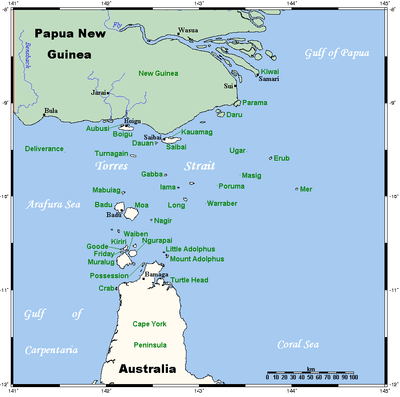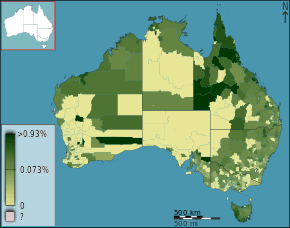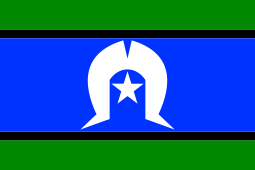Torres Strait Islanders
|
| |
| Total population | |
|---|---|
| 48,005 | |
| Regions with significant populations | |
|
| |
| Languages | |
| see Torres Strait Island languages | |
| Religion | |
| Christianity | |
| Related ethnic groups | |
| Aboriginal Australians, Papuans, Melanesians |

Torres Strait Islanders /ˈtɔːrᵻs/ are the indigenous people of the Torres Strait Islands, part of Queensland, Australia. They are culturally and genetically Melanesian people, as are the people of Papua New Guinea. They are distinct from the Aboriginal people of the rest of Australia, and are generally referred to separately. There are also two Torres Strait Islander communities on the nearby coast of the mainland at Bamaga and Seisia.
Population

There are 6,800 Torres Strait Islanders who live in the area of the Torres Strait, and 42,000 others who live outside of this area, mostly in the north of Queensland, particularly in Townsville and Cairns. There are 42,005 of them.[1]
Culture
The indigenous people of the Torres Strait have a distinct culture which has slight variants on the different islands where they live. They are a seafaring people, and they trade with people of Papua New Guinea. The culture is complex, with some Australian elements, some Papuan elements, and Austronesian elements, just like the languages. The Islanders seem to have been the dominant culture for many centuries, and neighbouring Aboriginal and Papuan cultures show some Island influence in religious ceremonies and the like. Examples of Torres Strait Islander language can be found on the State Library of Queensland's "ReTold" website, a collection of online stories gathered in partnership with Torres Strait Islander language speakers and community members living in mainland Queensland. Stories told through this website come from the Margaret Lawrie Collection of Torres Strait Islanders material.
Archaeological, linguistic and folk history evidence suggests that the core of Island culture is Papuo-Austronesian. Unlike the indigenous peoples of mainland Australia, but like those of neighbouring Papua, the islanders are agriculturalists, although they supplemented their food supplies through hunting and gathering. Dugong, turtle, crayfish, crabs, shellfish, reef fish and wild fruits and vegetables were all traditionally hunted and collected and remain an important part of their subsistence lifestyle.[2] Traditional foods play an important role in ceremonies and celebrations even when they don't live on the islands. Dugong and turtle hunting as well as fishing are seen as a way of continuing the Islander tradition of being closely associated with the sea.[2]
Their more recent, post-colonization history has seen new cultural influences, most notably the place of Christianity (particularly of the Baptist and Anglican strains) which caused major shifts in cultural paradigms, as well as subtler additions through the influence of Polynesians, particularly Samoan and Rotuman sea workers and missionaries who worked in the area in the 19th Century.
Stories, crafts, and games
The inhabitants of Torres Strait have a long history of developing stories, crafts and games. Prominent among these is wame (alt. wameya), many different string figures[3][4][5] (a particular string figure game played by two or more participants that generates several string figures is familiar to people of many cultures under the name Cat's cradle), some extremely elaborate and beautiful, and 'string catches' (games in which strings are wrapped around fingers then removed quickly with a single pull).
Languages
The Western-central Torres Strait Language, or Kala Lagaw Ya, is spoken on the southwestern, western, northern and central islands. It is an Australian Aboriginal language. Meriam Mir is spoken on the eastern islands. It is one of the Eastern Trans-Fly languages, otherwise spoken in Papua New Guinea.[6]
Administration
The Torres Strait Islanders have been administered by a system of elected councils.[7] This is a system based partly on traditional pre-Christian local government and partly on the introduced mission management system.[7]
Notable Islanders
- Eddie Mabo - Mabo Day is an official holiday in the Torres Shire, celebrated on 3 June.
- Christine Anu - is an Torres Strait Islander pop singer and actress.
- Michael Bani – Former NRL player for North Queensland Cowboys 8 Manly Warringah Sea Eagles.
- Ben Barba – NRL player for Cronulla Sharks
- Seaman Dan - is a Torres Strait Islander singer-songwriter
- Dane Gagai - NRL player for Newcastle Knights
- Eleanor Harding - (1934-1996) Aboriginal Rights Activist from Erub Island
- Josh Hoffman - NRL player for Gold Coast Titans
- Nathan Jawai – Basketball player formerly with the Toronto Raptors and Minnesota Timberwolves
- Rod Jensen - former Rugby League Player for Adelaide Rams, Canberra Raiders, North Queensland Cowboys & Huddersfield Giants.
- Patty Mills – Point guard for the San Antonio Spurs and the Australia national team.
- Danny Morseu – Former basketball player and member of the NBL Hall of Fame
- Martin Nakata – The first Torres Strait Islander to gain PhD qualifications, director of the University of New South Wales' Indigenous Programs Unit, known as Nura Gili[8]
- Albert Proud – Australian Football League player for Brisbane Lions[9]
- Wendell Sailor – former National Rugby League player for Brisbane Broncos
- Sam Thaiday – NRL player for Brisbane Broncos
- Leilani Latu - NRL player for Penrith Panthers
- Edrick Lee - NRL player for Canberra Raiders
- Brenko Lee - NRL player for Canberra Raiders
- Robert Lui – NRL player for Wests Tigers
- Palmer Wapau - former NRL Player for Brisbane Broncos
- Brent Webb – Super League player for Leeds Rhinos and New Zealand National Team.
See also
- Aboriginal Centre for the Performing Arts (ACPA)
- Indigenous Australians
- List of Indigenous Australian firsts
- Torres Strait Islander Flag
References
- ↑ "Australia's Aboriginal and Torres Strait Islander peoples". Australia Now. Australian Government, Department of Foreign Affairs and Trade. Archived from the original on 8 October 2006. Retrieved 10 December 2006.
- 1 2 Smyth, Dermot (2002). "Appendix B: The Indigenous Sector: An Anthropological Perspective". In Hundloe, Tor. Valuing Fisheries. University of Queensland Press. pp. 230–231. ISBN 0702233293. Retrieved 4 November 2012.
- ↑ Brij V. Lal; Kate Fortune, eds. (2000). The Pacific Islands: An Encyclopedia. University of Hawaii Press. p. 456. ISBN 978-0-8248-2265-1. Retrieved 7 March 2016.
- ↑ Alfred Cort Haddon, along with one of his daughters, the pioneers in the modern study of Torres Strait string figures
- ↑ A string figure bibliography including examples from Torres Strait.
- ↑ "Indigenous Fact Sheet: Torres Strait Islanders" (PDF). Australian Government, Department of Families, Community Services and Indigenous Affairs. Archived from the original (PDF) on 18 May 2006. Retrieved 10 December 2006.
- 1 2 Jeremy Beckett (1990). Torres Strait Islanders: Custom and Colonialism. Cambridge University Press. pp. 17–18. ISBN 978-0-521-37862-8. Retrieved 7 March 2016.
- ↑ "Director of Nura Gili - Professor Martin Nakata". University of New South Wales. Retrieved 6 March 2016.
- ↑ AFL Record. Round 9,2009. Slattery Publishing. pg 75.
External links
| Library resources about Torres Strait Islanders |
- Torres Strait Regional Authority
- Church of Torres Strait
- Aboriginal and Torres Strait Islanders' virtual books – held by the State Library of Queensland.
- Contemporary stories by and about Aboriginal and Torres Strait Islander people
- Aboriginal and Torres Strait Islander Social Justice Commissioner, Social Justice Reports 1993–2015 and Native Title Reports 1994–2015 for more information about Aboriginal and Torres Strait Islander affairs.
